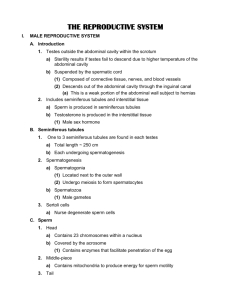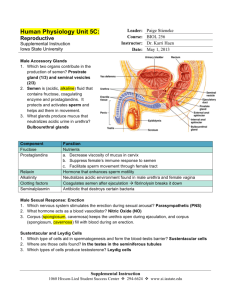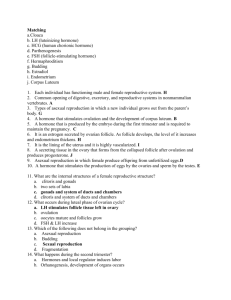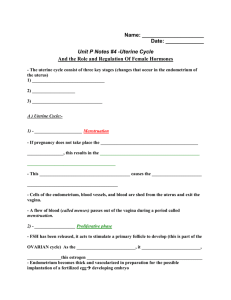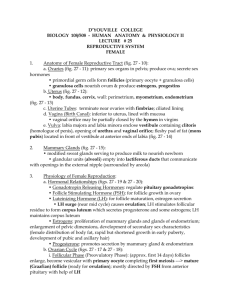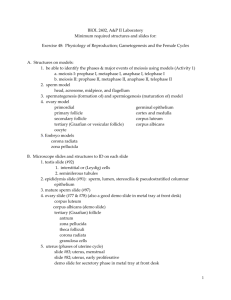Final Exam Rev #5 KEY
advertisement
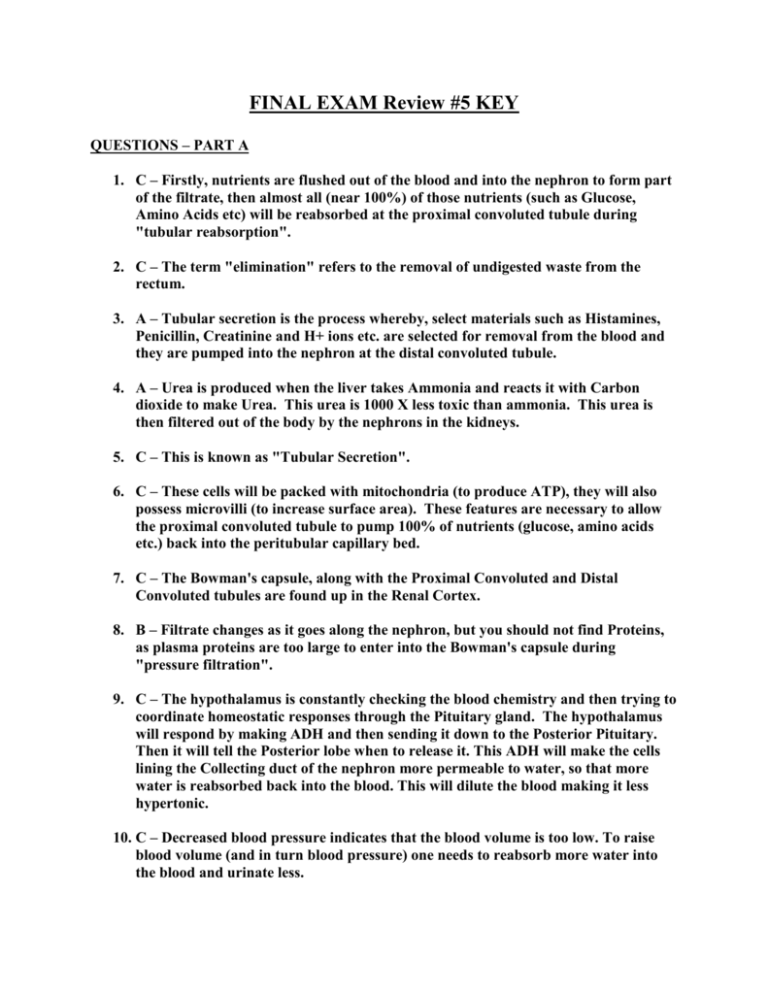
FINAL EXAM Review #5 KEY QUESTIONS – PART A 1. C – Firstly, nutrients are flushed out of the blood and into the nephron to form part of the filtrate, then almost all (near 100%) of those nutrients (such as Glucose, Amino Acids etc) will be reabsorbed at the proximal convoluted tubule during "tubular reabsorption". 2. C – The term "elimination" refers to the removal of undigested waste from the rectum. 3. A – Tubular secretion is the process whereby, select materials such as Histamines, Penicillin, Creatinine and H+ ions etc. are selected for removal from the blood and they are pumped into the nephron at the distal convoluted tubule. 4. A – Urea is produced when the liver takes Ammonia and reacts it with Carbon dioxide to make Urea. This urea is 1000 X less toxic than ammonia. This urea is then filtered out of the body by the nephrons in the kidneys. 5. C – This is known as "Tubular Secretion". 6. C – These cells will be packed with mitochondria (to produce ATP), they will also possess microvilli (to increase surface area). These features are necessary to allow the proximal convoluted tubule to pump 100% of nutrients (glucose, amino acids etc.) back into the peritubular capillary bed. 7. C – The Bowman's capsule, along with the Proximal Convoluted and Distal Convoluted tubules are found up in the Renal Cortex. 8. B – Filtrate changes as it goes along the nephron, but you should not find Proteins, as plasma proteins are too large to enter into the Bowman's capsule during "pressure filtration". 9. C – The hypothalamus is constantly checking the blood chemistry and then trying to coordinate homeostatic responses through the Pituitary gland. The hypothalamus will respond by making ADH and then sending it down to the Posterior Pituitary. Then it will tell the Posterior lobe when to release it. This ADH will make the cells lining the Collecting duct of the nephron more permeable to water, so that more water is reabsorbed back into the blood. This will dilute the blood making it less hypertonic. 10. C – Decreased blood pressure indicates that the blood volume is too low. To raise blood volume (and in turn blood pressure) one needs to reabsorb more water into the blood and urinate less. SHORT ANSWER – PART A 11. A) Kidney filters blood to make urine, also plays a role to regulate blood volume, and blood pH. B) Ureter is a muscular tube that conducts urine from the renal pelvis to the urinary bladder. C) Urinary Bladder temporarily stores urine and then releases sphincter muscles and contracts to send urine into the urethra. D) Urethra is the tube that carries urine outside the body. In a male it also acts to carry semen out through the penis. 12. SEE PICTURE BELOW: 13. The renal pelvis is the region of the kidney where all the collecting ducts have sent their urine. 14. SEE PICTURE BELOW: 15. SEE SUMMARY DIAGRAM BELOW: or p. 308 16. ADH – Antidiuretic Hormone which is produced in the hypothalamus but stored and released from the Posterior Pituitary will cause the cells of the collecting duct to become more permeable to water. This will allow for more reabsorption of water from the filtrate as it moves down the collecting duct. Result: blood volume and blood pressure go up, while urine output goes down. Aldosterone – Aldosterone is produced and released from the adrenal gland when the levels of sodium in the blood are too low. This Aldosterone will activate the cells to the Distal Convoluted tubule to turn on sodium pumps to actively pump more sodium ions from the filtrate back into the blood. This will also cause more water to follow which will again increase blood volume and blood pressure. 17. See Answer above as Hypothalamus and Posterior Pituitary roles were mentioned in the answer for ADH. 18. See the role of the adrenal gland in producing Aldosterone covered in answer #16 and see picture below: QUESTIONS – PART B 1. D – The inner lining of the uterus that undergoes changes during the uterine cycle is called the endometrium. 2. A – The testis produces hormones (testosterone) which is released into the bloodstream. All the others act in an exocrine fashion, making substance which travel through ducts and then enter a space in the body. 3. A – Oxytocin which is made by the Hypothalamus but stored and released from the Posterior Pituitary, will stimulate uterine contractions and trigger milk let-down from the mammary glands of the breasts. 4. C – Human Chorionic Gonadotropin (HCG) Hormone is produced by the membranes around the early developing embryo. It targets the female gonads (ovaries) causing them to maintain the corpus luteum which in turn keeps the levels of Estrogen and Progesterone high. These high levels will communicate to the endometrium to stay intact and prevent menses. 5. B – Urethra serves dual purpose in the male. 6. C – Sperm will not enter the Seminal Vesicles, but the contents of the seminal vesicles (prostaglandins and fructose etc) will be added to the sperm (to help form semen) as it enters the ejaculatory duct and travels into the urethra. 7. D – A spike in Lutenizing Hormone (LH) is responsible for triggering ovulation as well as helping convert the broken Graafian follicle into the Corpus Luteum. 8. B – Egg is released from the swollen follicle, usually around day 14 of the ovarian cycle. 9. C – Fertilization normally takes place as the ovum migrates down the oviduct (fallopian tube) then it takes another 3-5 days until the developing embryo (blastocyst) actually reaches the uterus and implants itself. 10. D – The ruptured follicle will develop into the Corpus Luteums. The corpus luteum produces and secretes progesterone and a few days later starts to increase production and release of estrogen. If no pregnancy (implantation) occurs, no HCG will be produced, and if so, the corpus luteum will just break down and the levels of estrogen and progesterone will crash. SHORT ANSWER – PART B 11. MALE REPRODUCTIVE SYSTEM – See information Below #1 - Vas Deferens – Tube that conducts sperm to urethra. #2 - Seminal Vesicle – Adds Prostaglandins and Fructose etc. #3 - Prostate Gland – Adds alkali solution to help counteract acidic vagina. #4 - Cowper's (Bulbourethral) Gland – Secretes mucous to lubricate urethra. #5 - Epididymis – Stores sperm while it matures. #6 - Testis (Testicle) – Produce sperm and Testosterone. #7 - Scrotum – Testes sac, helps keep testes at lower temperature for optimal spermatogenesis. #8 - Penis – Copulation (intercourse) #10 - Urinary Bladder – Temporarily stores urine. #11 - Urethra – Tube to conduct urine and semen FEMALE – See information below. 12. The components of semen are as follows see table: COMPONENT SOURCE Sperm Seminiferous Tubules inside the lobules of the testes Prostaglandins Seminal Vesicles Fructose Seminal Vesicles Alkali Mixture Prostate Gland Mucous Solution Cowper's (Bulbourethral) Gland FUNCTION To carry genetic information to be united with the female egg during fertilization. To stimulate uterine contractions in the female to help drive sperm up toward oviduct (fallopian tube) To provide a carbohydrate as an energy source for the sperm cells to help them produce adequate amounts of ATP for their flagella To make semen more basic so that when it encounters the acidic environment of the vagina, it can neutralize the pH to keep the sperm mobile and viable. To add a lubricant to the semen to lubricate the urethra. To help the sperm along 13. Hormone table see below: HORMONE SOURCE ESTROGEN Developing Follicle and also from Corpus Luteum PROGESTERONE Mostly from the Corpus Luteum TARGET A number of areas in the female, but we were mostly concerned with its effect on the endometrium Again targets a number of areas in the female, but we are mostly concerned for its effect on the endometrium Human Chorionic Gonadotropin (HCG) The chorion membrane around the developing embryo Targets the ovaries Lutenizing Hormone (LH) Produced in the Anterior Pituitary Gland Targets Interstitial Cells in the testes. Targets the Follicle in the ovaries Follicle Stimulating Hormone (FSH) Produced in the Anterior Pituitary Gland Targets the Seminiferous Tubule cells in the testes in the male. Targets the primary follicle in the female ovary EFFECT Signals the Uterus to re-build the endometrium and start the (Proliferative) phase of the Uterine Cycle. Progesterone signals the Uterus to double-triple the thickness of the endometrium. It also signals the uterine glands to secrete heavy levels of mucous. This primes the endometrium to get ready for possible implantation. These changes to the endometrium take place during the Secretory phase of the Uterine cycle. Signals the ovaries to keep the Corpus Luteum healthy and prevent it from degenerating. So in turn it helps make sure the corpus luteum keeps up Estrogen and Progesterone levels where they need to be during Pregnancy. Eventually the placental membranes will produce all their own pregnancy hormones Causes the interstitial cells to step up production of Testosterone. Causes the Developing Follicle to rupture to release egg during ovulation and to convert ruptured follicle into the corpus luteum. FSH will stimulate spermatogenesis in the Seminiferous tubules. FSH will stimulate a primary follicle to undergo development over the follicular phase to develop an ovum (egg) Human Chorionic Gonadotropin Hormone (HCG GnRH Gonadotropic Release Hormone TESTOSTERONE Made and released from developing membranes around the implanted embryo (blastocyst) Produced in the Hypothalamus Targets the ovaries Signals the ovaries that pregnancy has occurred and that the Corpus Luteum needs to stay healthy to maintain high levels of estrogen and progesterone. Targets the cells of the Anterior Pituitary Interstitial Cells of the Testes Targets a number of areas in the male. Such as penis, seminiferous tubules and brain. Triggers the anterior pituitary gland to produce and release Gonadotropin Hormones (LH and FSH) Triggers the growth and development of the penis and testis. Adequate levels of testosterone are necessary to help run spermatogenesis 14. GnRF stands for Gonadotropic Release Factor AKA Gonadotropic Release Hormone. See table above 15. A good example of Negative Feedback is when the body stimulates a mechanism to fix something that is out of balance. Once the imbalance is corrected the body needs to shut off that mechanism. For Example if Testosterone levels in the body are too low, the Hypothalamus will release GnRH (Gonadotropic Release Hormone) which will trigger the cells of the Anterior Pituitary to produce and release more LH (Lutenizing Hormone) into the blood. This LH will stimulate the Interstitial cells in the testes to produce more Testosterone. After Testosterone levels are adequate, the Hypothalamus will produce and release GnIH (Gonadotropic Inhibiting Hormone) this hormone will direct the anterior lobe to decrease the amount of LH it should be putting out. 16. A) During Ovulation a mature egg is releases from the Graafian Follicle. During Ejaculation semen is ejected from the Penis. B) The Follicle has cells that undergo Meiosis to produce the egg. It also has granulosa cells to produce and release higher levels of estrogen. The corpus luteum forms from the ruptured follicle, it produces and releases higher levels of progesterone and estrogen during the luteal phase of the ovarian cycle. C) Sperm is the haploid male gamete that needs a flagellum to swim up the uterus and oviducts. Ovum is the haploid female gamete that needs to be fertilized by the sperm to form the first diploid cell, the zygote. 17. When the egg is fertilized by the sperm and a diploid zygote develops. A number of changes take place to the female body, but we do not need to study pregnancy. You only need to know that when the embryo implants itself, the membranes will put out HCG to signal the Corpus Luteum to stay active pumping out Progesterone and Estrogen. 18. The hypothalamus is constantly checking estrogen and progesterone (in female) and testosterone and inhibin levels (in the male). When these levels are low, it will produce and release GnRH which triggers the anterior lobe to step up production and release of LH and FSH.


